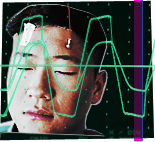Understanding Biofeedback
Related Media: Stress – Healthy Coping Methods
Imagine having hands so sensitive to cold that each winter they would swell and split open, so that just grabbing a carton of milk out of the refrigerator makes them whiten and throb with pain. Then imagine learning to raise the temperature in your hands so that you could hold the carton of milk and do it without any pain. This is an example of what biofeedback training is attempting to accomplish for certain medical problems, such as Raynaud’s disease, a circulatory disorder that can cause its victims extreme discomfort and debilitation. For Raynaud’s disease, this therapy has not been found to be clearly effective, but there may be benefits for some other conditions.
Currently, incomplete but encouraging evidence suggests that biofeedback may indeed offer at least modest benefits for a variety of conditions, including anxiety, low back pain, insomnia, and female stress incontinence. There is mixed evidence as to whether biofeedback helps with migraine and tension headaches.
The major advantages of biofeedback are that it is noninvasive, has virtually no side effects, and is possibly effective over the long-term. The major disadvantage for some is that it requires effort, commitment, and involvement on the part of patients.
How Biofeedback Works
 Every time you scratch an itch, grab a snack when you’re hungry, or use the bathroom when you feel the urge, you are responding to biofeedback cues from your body about your physiological state.
Every time you scratch an itch, grab a snack when you’re hungry, or use the bathroom when you feel the urge, you are responding to biofeedback cues from your body about your physiological state.
With biofeedback training, however, you are cued by sensors attached to your body. These sensors measure heart rate, the temperature of your extremities, the muscle tension in specific muscle groups, or, in neurofeedback, the kinds of brain waves you are emitting. This information is conveyed by visual displays or sounds. Using imagery and mental exercises, you learn to control these functions, using the feedback provided by the sensors as a gauge of success. With practice, you can learn to “tune in” without instrumentation and control these functions at will during ordinary life.
For example, in a biofeedback training session for headache, temperature sensors would be attached first to your hands, then to your feet, and finally to your forehead, if needed. Your goal would be to increase blood flow away from the brain by raising the temperature in your hands and feet and eventually lowering it in your temples. Other sensors might monitor your electrodermal or galvanic skin response, how easily you sweat or get goose bumps, because this affects your ability to alter your skin temperature.
To warm up your hands and feet, you might imagine basking in the sun on a beach while listening to a script like “I feel warm…my hands are growing warm and heavy…” Both the image and the script would be tailored to you personally to evoke a vivid and relaxing mental image. After your training session, you would be sent home with an audio version of the script and small thermometers to use for your daily practice.
Who Needs to Be Involved With Biofeedback?
Any biofeedback treatment program should involve your primary healthcare provider and relevant specialists, such as urologists, cardiologists, or neurologists. The training is often most effective when integrated with other types of therapy, such as medicine or cognitive-behavioral therapy.
Neurofeedback
Neurofeedback, also called EEG feedback, is the most controversial form of biofeedback therapy, largely because so few controlled clinical trials have been able to assess its efficacy. Neurofeedback is the “retraining” of brainwave patterns. Although controversial, it is experiencing a resurgence of interest in the treatment of a variety of disorders, including depression, fibromyalgia, attention-deficit hyperactivity disorder (ADHD), and alcoholism.
In a neurofeedback training session, several sensors that measure your brain’s electrical activity are attached to your scalp. You relax and play a video game, which is controlled just by your brain waves and responds favorably to brain waves of the desired pattern. As you play the game, your trainer observes your electroencephalogram (EEG), transmitted to a separate video terminal. Most practitioners recommend at least 20 sessions to obtain significant, long-lasting results, although improvement is usually noted early on if the treatment protocol is right for you.
A note of caution: Be sure that the practitioner that you choose to work with has training and experience in using neurofeedback. Ask lots of questions and talk with your primary care doctor before starting a treatment program.
REFERENCES:
Duckro PN, Cantwell-Simmons E. A review of studies evaluating biofeedback and relaxation training in the management of pediatric headache. Headache. 1989;29:428-433.
Freedman RR, Ianni P, Wenig P. Behavioral treatment of Raynaud’s phenomenon in scleroderma. J Behav Med. 1984;7:343-353.
Hermann C, Blanchard EB. Biofeedback in the treatment of headache and other childhood pain. Appl Psychophysiol Biofeedback. 2002;27:143-162.
LakeAE3rd. Behavioral and nonpharmacologic treatments of headache. Med Clin North Am. 2001;85:1055-1075.





